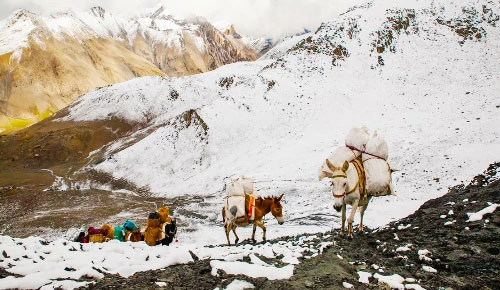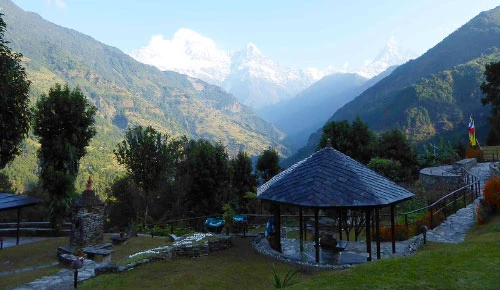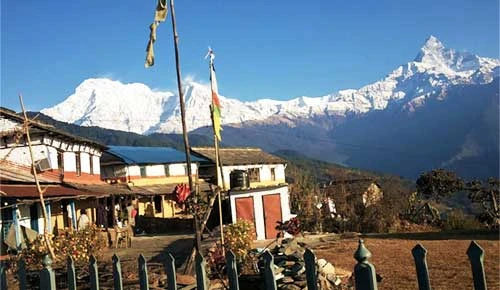Nar-Phu Valley Travel Guide
Nar-Phu Valley is a remote and isolated valley located in the Annapurna region of Nepal. It is located approximately 60 km north of the city of Pokhara and is considered one of the least visited trekking destinations in the country.
Accessibility to Nar-Phu Valley can be a challenge, as the only way to reach the valley is by foot. The nearest road head is at Koto, which is a two-day trek from the valley. Alternatively, travelers can fly to Jomsom and then trek to the valley, which takes around five days.
The valley is surrounded by towering peaks, including Annapurna II, Annapurna IV, Gangapurna, and Tilicho Peak. It is home to diverse landscapes, including alpine meadows, high-altitude deserts, and dense forests.
Nar-Phu Valley is also significant for its cultural heritage, as it is inhabited by two distinct ethnic groups, the Nar and Phu communities. These communities have a unique culture and lifestyle and have managed to maintain their traditions and practices despite the limited access and remote location of the valley. The valley is also home to several ancient monasteries, which are revered by the local communities and are considered essential pilgrimage sites.
Best time to Visit Nar-Phu valley
The best time to Visit Nar Phu valley is from September to November and March to May, during the spring and autumn season when the weather is relatively clear and stable. During the monsoon season from June to August, there is a high chance of heavy rainfall and landslides, making it difficult to trek.
Accommodation in Nar-Phu Valley
Accommodation options in Nar-Phu Valley range from basic to luxurious.
Tent camping and trekking lodges are the most common form of accommodation for trekkers in the valley. These lodges are simple and provide basic amenities such as a place to sleep, a hot meal, and a toilet. However, they can be crowded and lack privacy, so they may not be suitable for those seeking more comfort.
Homestays are another option for those who want to experience the local culture and lifestyle of the Nar and Phu communities. Homestays are typically basic but offer a unique and authentic experience, and provide an opportunity to interact with the local people and learn about their culture and traditions.
Luxury lodges are also available for those who are looking for a more comfortable and upscale experience. These lodges are equipped with modern amenities, including hot showers and comfortable beds, and provide a more luxurious option for those who want to relax and unwind after a long day of trekking.
Regardless of the accommodation type you choose, it's important to keep in mind that most of the lodges in the Nar-Phu Valley run on a generator and may not have 24-hour electricity, so it's best to come prepared with a headlamp or flashlight and warm clothing for the chilly evenings.
Trekking in Nar-Phu Valley
Trekking in Nar-Phu Valley can be an unforgettable experience, offering breathtaking views of the surrounding peaks and the chance to explore the unique culture and traditions of the Nar and Phu communities.
There are several trekking routes in Nar-Phu Valley, varying in length and difficulty. The most popular route is the Nar-Phu Valley Trek, which takes around 14-16 days and covers a distance of approximately 140 km. This route takes trekkers through remote villages, across high mountain passes, and through diverse landscapes, offering a true adventure in the heart of the Himalayas.
Other trekking routes in Nar-Phu Valley include the Thorong La Pass Trek, which takes trekkers over the Thorong La Pass and offers panoramic views of the Annapurna range, and the Tilicho Lake Trek, which takes trekkers to Tilicho Lake, the highest lake in the world.
Some of the most popular trekking destinations in Nar-Phu Valley include:
- Phu Village: A remote and isolated village located at the heart of the valley, known for its traditional homes, stunning views, and the Phu Monastery.
- Kang La Pass: A high mountain pass offering panoramic views of the surrounding peaks and the chance to spot rare and exotic wildlife.
- Nar Monastery: A revered and ancient Buddhist monastery located in Nar Village, known for its unique architecture and rich cultural history.
When trekking in Nar-Phu Valley, it is important to bring the right gear and equipment to ensure a safe and comfortable journey. Essential gear includes comfortable and waterproof trekking boots, warm and waterproof clothing, a good quality backpack, a sleeping bag, a trekking tent, a headlamp, and a first-aid kit. Additionally, trekkers should also bring adequate supplies of food and water, as well as a high-altitude sickness kit to prevent altitude sickness.
Local Culture and Festivals
Nar and Phu's communities are two distinct ethnic groups that inhabit the Nar-Phu Valley in Nepal. They have their own unique cultural practices, beliefs, and customs, which have been passed down from generation to generation.
The Nar community is primarily engaged in agriculture and animal husbandry, while the Phu community is known for its skills in weaving and trading. Both communities have a strong spiritual traditions, and many of their religious practices are centered around their relationship with nature and the environment.
Several religious festivals are celebrated in the Nar-Phu Valley throughout the year. Some of the most significant festivals include:
- Losar: Celebrated in February, Losar is the Tibetan New Year and is marked by feasts, music, and dance.
- Mani Rimdu: A three-day festival held in the autumn months, Mani Rimdu is a religious celebration that includes prayers, dance, and offerings to the gods.
- Tiji: A three-day festival held in the spring, Tiji is a celebration of the triumph of good over evil and is marked by prayers, dance, and music.
- Dashain: Celebrated in September/October, Dashain is the most important Hindu festival in Nepal and is celebrated with feasts, music, and offerings to the gods.
These festivals provide an opportunity for travelers to experience the rich culture and traditions of the Nar and Phu communities and to learn more about their beliefs and practices.
Wildlife and Natural Beauty
Nar-Phu Valley is rich in flora and fauna, making it a prime destination for nature lovers and wildlife enthusiasts. The valley is home to a diverse range of species, including endemic and threatened species.
The valley is surrounded by dense forests that are home to a wide variety of wildlife, including Himalayan black bears, snow leopards, and red pandas. Birdwatchers will also find the valley to be a paradise, as it is home to several species of high-altitude birds, including the Himalayan griffon, lammergeier, and impeyan pheasant.
In terms of flora, the valley is known for its diverse range of plants and flowers, including alpine meadows that are covered in a carpet of wildflowers in the spring and summer months. The valley is also home to several species of rhododendrons, which bloom in the spring and add a burst of color to the landscape.
For wildlife spotting opportunities, travelers can take guided walks through the forests or go on early morning and late afternoon walks, as these are the best times to spot wildlife. In addition, travelers can also visit the nearby national parks and conservation areas, such as the Annapurna Conservation Area and the Langtang National Park, which are home to a wide range of wildlife species.
Safety and Health Consideration
When trekking in Nar-Phu Valley, it's important to be mindful of the potential health and safety risks associated with high-altitude trekking. Here are some key considerations:
Altitude Sickness: Nar-Phu Valley is located at a high altitude, with several passes reaching over 5,000 meters. Altitude sickness is a common concern for trekkers, and symptoms can include headache, fatigue, nausea, and dizziness. To minimize the risk of altitude sickness, it's important to acclimate gradually and give your body time to adjust to the increased altitude. This can be done by taking regular rests and drinking plenty of water.
Other Health Concerns: In addition to altitude sickness, other health concerns to be aware of while trekking in Nar-Phu Valley include dehydration, hypothermia, and foodborne illness. To minimize the risk of these health issues, it's important to stay hydrated, dress in layers, and be mindful of what you eat and drink.
Safety Tips for Trekking:
- Hire a reputable trekking guide who is familiar with the trail and the local conditions.
- Always carry sufficient food and water, as well as basic first aid supplies.
- Be mindful of the weather conditions, as snow, ice, and strong winds can make the trail treacherous.
- Respect the local culture and customs, and be mindful of your impact on the environment.
- Avoid trekking alone, and let someone know your itinerary before setting out.
By following these safety and health considerations and taking the necessary precautions, you can help ensure a safe and enjoyable trekking experience in Nar-Phu Valley.
Trekking packages that take to Nar-Phu valley and recommendations
There are several trekking packages available that take travelers to the Nar-Phu Valley. Here are some popular packages:
- Nar-Phu Valley Trek: This is a classic trek that takes travelers through the valley, passing through several traditional villages and visiting historic monasteries. The trek typically lasts 12 to 14 days, starting and ending in either Koto or Jomsom.
- Annapurna Circuit Trek with Nar-Phu Extension: This is a combination of the popular Annapurna Circuit Trek and the Nar-Phu Valley Trek. The trek typically lasts around 20 to 22 days, starting and ending in Kathmandu.
- Tilicho Lake and Nar-Phu Valley Trek: This is a unique trek that combines the Nar-Phu Valley Trek with a visit to Tilicho Lake, which is considered one of the highest lakes in the world. The trek typically lasts around 18 to 20 days, starting and ending in either Koto or Jomsom.
- Annapurna Circuit and Nar-Phu Valley Trek with Helicopter Return: This is a more comfortable and efficient way to experience the Nar-Phu Valley. The trek typically lasts around 10 to 12 days, starting in Koto and ending in Pokhara, with a helicopter return to Pokhara.
When choosing a trekking package, it is important to consider factors such as your fitness level, budget, and time constraints. It is also recommended to choose a reputable trekking agency and to make sure that they have proper equipment and support staff, such as guides and porters, to ensure a safe and enjoyable trek.



